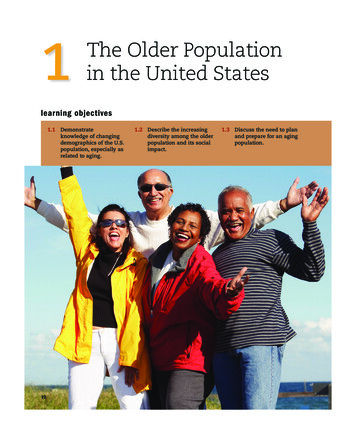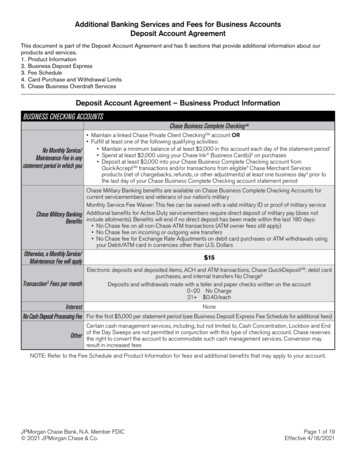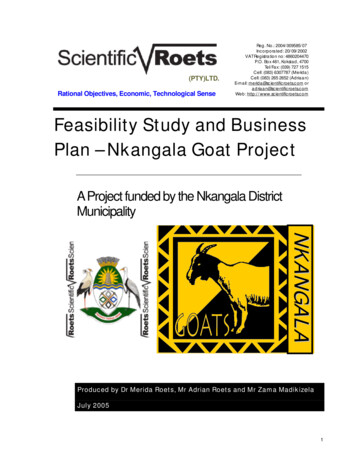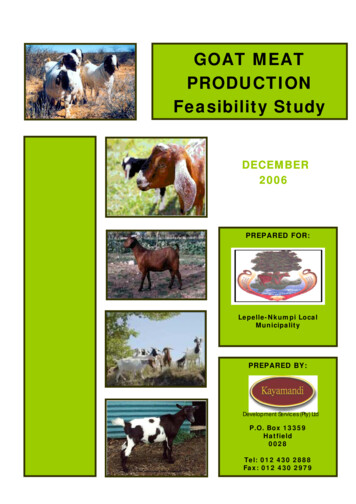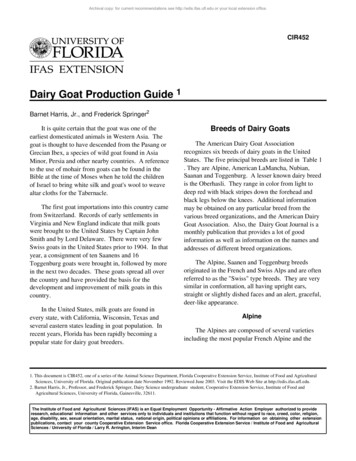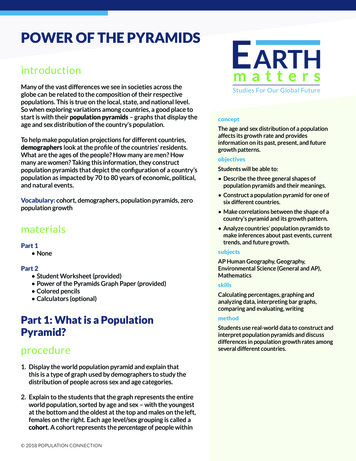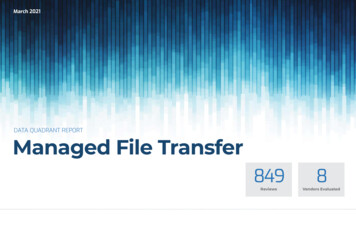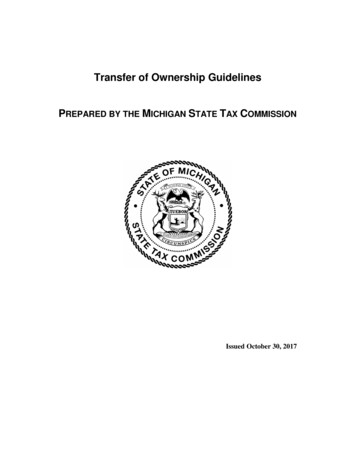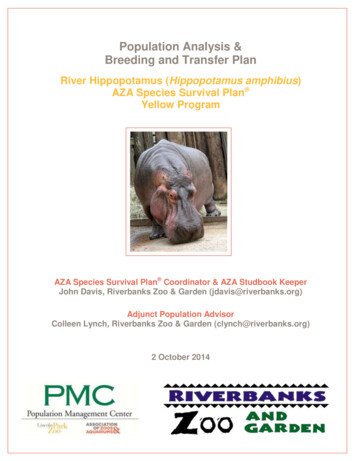
Transcription
Population Analysis &Breeding and Transfer PlanRiver Hippopotamus (Hippopotamus amphibius)AZA Species Survival Plan Yellow ProgramAZA Species Survival Plan Coordinator & AZA Studbook KeeperJohn Davis, Riverbanks Zoo & Garden (jdavis@riverbanks.org)Adjunct Population AdvisorColleen Lynch, Riverbanks Zoo & Garden (clynch@riverbanks.org)2 October 2014
Executive Summary Species Survival Plan for the River Hippopotamus (Hippopotamus amphibius)The river hippopotamus population at the time of analysis consists of 98 (37.60.1) individuals at 37 institutionsin Canada, the United States, and Mexico. The Wild Pig, Peccary, and Hippo Taxon Advisory Group (TAG)designated the River hippopotamus to be managed as a SSP in their 2008 Regional Collection Plan (RCP) witha target population size of 101. This population currently qualifies as a Yellow SSP Program.Of special concern to this population is the high degree of unknownness in the pedigree. Only 55% of the livingpopulation’s pedigree is known (i.e., traces back to known or assumed wild ancestors). Genetic managementof this population can only be conducted in a rudimentary fashion by avoiding close inbreeding where possibleand by attempting to keep family lines equal. However, due to the long lifespans of these animals, even asimple genetic management strategy such as avoidance of close inbreeding will be difficult to implement forthose animals with unknown pedigrees and unknown origins. The Program should continue to investigateunknown origin & unknown pedigree animals in order to facilitate future genetic management.DemographyCurrent size of population (N) - Total (Males, Females, Unknown)98 (37.60.1)# animals excluded from management11Population size following exclusions87Target population size101Mean generation time (yrs)16.19Historic/Projected population growth rate (lambda)Genetics (Genetic statistics calculated from the analytical 716.17Gene diversity (GD%)94.7296.91Population mean kinship (MK)0.0528Mean inbreeding (F)0.0228Founder genome equivalents (FGE)Percentage of pedigree known before assumptions and exclusions44Percentage of pedigree known after assumptions and exclusions55Effective population size/census size ratio (Ne / N)0.3346Years To 90% Gene Diversity53Years to 10% Loss of Gene Diversity127Gene Diversity at 100 Years From Present (%)Assuming λ 1.031, Target size 10186*Note: Genetic analyses are based solely on the portion of the pedigree that is known or assumed in the analytical studbook (55%)and as a result do not accurately reflect the genetic status of the entire living population.According to demographic projections, the population can be maintained at its current size (0% growth rate orlambda 1.00) with approximately three to four births per year. Any additional births are expected to result inpopulation growth. The SSP will need to be careful that breeding is not limited to a small number of individualsso that representation of family lineages remains relatively equal and future inbreeding is avoided.New institutions or institutions interested in housing additional animals should contact the SSPCoordinator. It is especially important that breeding facilities be recruited to the program and facilitieshousing only females may be asked in the near future to accept males and initiate breeding.Summary Actions: The SSP recommends 4 females for breeding, though only two pairs are logisticallypossible in the next year. In addition, 3 transfers are recommended.This Animal Program is currently a Yellow SSP and recommendations proposed are non-binding – Participation isvoluntary. Dispositions to non-AZA institutions should comply with each institution's acquisition/disposition policy.1
Table of ContentsExecutive Summary1Description of Population StatusIntroduction3Analytical Population3Demography3Genetics4Management StrategyRecommendations5Summary Recommendations6ADVENTURE, ALDERGROVE, BIRMINGHM, BUSCH TAM,11CALGARY, CINCINNAT, COLO SPRG, DENVER, DICKERSON12DISNEY AK, FORTWORTH, GRANBY,13GUADALJR , HOMOSASSA, HONOLULU,14KANSASCTY, LEON , LOSANGELE, LUFKIN,15MEMPHIS, MILWAUKEE, MONROE, PHILADELP,16PORTLAND, PUEBLA, RIO GRAND, SAN ANTON,17SAN FRAN , SANDIEGOZ, SEATTLE, SEDGWICK,18ST LOUIS , STEVENSVI, TOLEDO, TOPEKA,19TORONTO, WINSTONAppendices20A. Pedigree Assumptions21B. Mean Kinship ListC. Summary of Data Exports2324D. Animals Excluded from the Genetic AnalysesE. Life Tables2425F. Survival StatisticsG. Definitions2831H. Directory of Institutional Representatives33SSP Coordinator/AZA Studbook Keeper:John Davis, Riverbanks Zoo & Botanical Gardens, 803-602-0886, jdavis@riverbanks.orgReport and Analyses Prepared By: ADJUNCT PMC ADVISORColleen Lynch, Riverbanks Zoo and Garden, clynch@riverbanks.orgThe river hippopotamus planning session was hosted by the Riverbanks Zoo and Garden on 14 AUG 2014Photo courtesy of Richard W. Rokes.This plan was prepared and distributed with the assistance of the AZA PopulationManagement Center in Chicago.pmc@lpzoo.orgThis Animal Program is currently a Yellow SSP and recommendations proposed are non-binding – Participation isvoluntary. Dispositions to non-AZA institutions should comply with each institution's acquisition/disposition policy.2
Descriptionof Population Status Species Survival Plan for the River (Nile) Hippopotamus (Hippopotamus amphibius)Introduction: The river hippopotamus population at the time of analysis is 98 animals (37.60.1) at 37 AZAinstitutions. The Wild Pig, Peccary, and Hippo Taxon Advisory Group has designated the river hippopotamus tobe managed as a SSP in the 2008 Regional Collection Plan with a target population size of 101 individuals. Thispopulation currently qualifies as a Yellow SSP Program.Comprehensive genetic and demographic analyses of the population were performed in August 2014 resultingin the current Breeding and Transfer Plan for this species. Analyses of the North American Regional RiverHippopotamus Studbook (current to 7/15/2014) were performed using PopLink 2.1 and PM2000 1.213 software.Recommendations in this plan are intended to help insure the genetic and demographic health of thispopulation. This is the fourth formal breeding and transfer report for this species, with the last report distributedin 2011. All recommendations proposed in a Yellow SSP Plan are non-binding; participation is voluntary.Analytical Population: Eleven animals (4.7) were excluded from the genetic analyses and the potentialbreeding population due to age, sterility, or reproductive issues (Appendix C). After exclusions the potentiallybreeding population consists of 87 (33.53.1) individuals.The pedigree of this population is approximately 44% known and over half the living animals in AZA zoos havesome part of their pedigree that is not known tracing back to 26 animals with unknown parentage (Appendix A).Parentage assumptions were made for 10 of these ancestors that were of probable wild origin or that had onlytwo potential parents on record at the institution at time of birth (also Appendix A); these assumptions increasedthe pedigree to 55% known. Even after all reasonable assumptions are applied, only 34 of the 87 animalsremaining after exclusions have 100% known pedigrees; 27 individuals remain having 0% known pedigrees. Nofurther assumptions were developed due to the serious implications of making incorrect assumptions for longlived animals with a potentially shallow pedigree. Institutions holding unknown pedigree individuals areencouraged to investigate the origins of their unknown pedigree animals in order to help determinerelatedness and genetic importance of animals in the living population.Demography: Studbook records indicate that the first hippopotamus in North American arrived at thePhiladelphia Zoo in 1884. The first well-documented zoo birth attributed to known parents occurred at theMemphis Zoo in 1916. Births in zoos began to become more common in the 1950s, and noticeably increasedin the 1970s and again in the late 1990s (Figure 1). In addition to zoo births, periodic imports from other regionshave supplemented the North American population, the latest occurring in 1998. Since 1998, the populationhas been in decline with a mean annual lambda of 0.997, and an overall decline of 8%.Figure 1. Census of river (Nile) hippos in North America and Mexico between 1930 – 2013 by birth type (left) and sex (right).According to studbook data for North American institutions from 1980 to present, first year mortality for riverhippos is 40% for males and 37% for females. Adult mortality appears to be very low but increases slightlystarting in the mid 30s. Median life expectancy is estimated at 34 years. Maximum longevity for hippos appearsto be at least the mid-50s, with the oldest male and female are currently alive at ages 57 years (SB#124) and53 years (SB#538), respectively.This Animal Program is currently a Yellow SSP and recommendations proposed are non-binding – Participation isvoluntary. Dispositions to non-AZA institutions should comply with each institution's acquisition/disposition policy.3
Ages at first reproduction have been observed as early as 2 years old for males and 3 years for females. Maleshave reproduced up until age 50 and females up to age 42, although female fecundity appears to declinestarting in the early 30s. It is unclear whether this decline is biological or an artifact of management, longlifespans, and small sample sizes.The age structure of the SSP population is fairly columnar in shape, reflecting the long lifespan of hippos andrelatively consistent births (or imports) filling in most age classes (Figure 2). One weakness in the age structureis a lower number of individuals in the youngest age classes, especially females. This is complicated throughmanagement by the practice of maintaining females in herds or pairs in the absence of males. However, at thistime the population has good reproductive potential with many breeding-aged or pre-reproductive animals, IFthose animals can be placed in breeding situations. An additional concern is the female-biased sex ratio of thepopulation. While a biased sex ratio may be compatible with the natural breeding biology of this species,having fewer males breeding can hasten the loss of gene diversity in the population.Figure 2. Age structure of the potentially breeding SSPRiver Hippopotamus population.Demographic projections estimate that maintainingthe population at its current size (0% growth rate orlambda 1.00), requires approximately three to fourbirths per annum. This number of births exceedsthe birth rate of the past 10 years (average of 2.1births/year).Management should encourage theaddition of breeding institutions in order to maintaina steady amount of births and a sufficient number ofmixed-sex breeding groups into the future.Institutional interest, however, has been decliningover the last several years and focus should beplaced on encouraging additional institutions to jointhe Program and maintain breeding or exhibitgroups.Genetics: The living population of river hippos in North America is only 44% known (55% known with geneticassumptions) and the genetic status of the overall population and individuals within it cannot be accuratelydetermined. Statistics below are based upon the known pedigree portion of the population and represent, atbest, only estimates of true values.GENETIC SUMMARYCurrent FoundersFounder genome equivalents (FGE)Gene diversity (GD %)Population mean kinship (MK)Mean inbreeding (F)Effective population size/census size ratio (Ne / N)Percentage of pedigree known before assumptions & exclusionsPercentage of pedigree known after assumptions & exclusionsYears To 90% Gene DiversityYears to 10% Loss of Gene DiversityGene Diversity at 100 Years From Present (%)Assumptions used for 2014 genetic projections λ 1.00, Kt A84.7020113310.2895.140.04860.02450.337455.462.056 86Potential016.1796.91----------*Note: Genetic analyses were based only on the portion of the pedigree that is known and as a result do not accurately reflect thegenetic status of the entire living population. Due to differences in assumptions and changes in the population, genetic values fromdifferent analyses are not directly comparable across years.Due to the long lifespans of these animals, even a simple genetic management strategy such as avoidance ofclose inbreeding will be difficult to implement for those animals with unknown pedigrees and unknown origins.Assumptions about the origin of animals cannot be easily made because births occurred as early as the earlyThis Animal Program is currently a Yellow SSP and recommendations proposed are non-binding – Participation isvoluntary. Dispositions to non-AZA institutions should comply with each institution's acquisition/disposition policy.4
1900s and imports from the wild occurred often enough to be a realistic source for some of today’s livinganimals or their parents. Furthermore, evidence of animals transferring between regions (Europe, USA,Mexico--in all directions) implies that there may be undocumented relatedness among regions. Geneticmanagement of this population can only be conducted in a rudimentary fashion by avoiding close inbreedingwhere possible and by attempting to keep family lines equal. Any additional information from institutionsregarding the origin of the animals in their care would be useful to the management of this population.Figure 3. Founder representation graph illustrating the inequality of the 33 known founder lineages represented in the current riverhippo population. Animals of unknown origin are not represented in this graph.Management Strategy: The current river hippopotamus population is 98 individuals at 37 institutions.Demographic analyses indicate that 3-4 in the coming year are required to maintain the current population size(lambda 1.00). Any births in addition to this are expected to result in population growth.Where possible pairing recommendations have been recommended with the consideration of mean kinship,avoidance of close inbreeding, and demographic needs of the population.1. The SSP recommends 4 females for breeding situations; though only two pairs are logistically feasiblein 2015 as transfers are required to set up the additional pairs. Institutions recommended to breed are expected to hold offspring for at least 3 years.2. The SSP recommends 3 transfers.3. The recruitment of breeding facilities is essential for the sustainability of this population. Facilitiesholding female herds or pairs may be needed in the short-term future to acquire males and produceoffspring.4. Institutions that interested in placing, receiving, or breeding should contact the SSP Coordinator.5. The SSP will begin to investigate a strategy for housing multiple males in bachelor groups as ademographic management strategy. Institutions interested in participating in this research are asked to contact the SSP Coordinator.6. Regarding unknown pedigree animals: Any additional information from institutions regarding the origin of the animals in their care (frompaper records, old newspaper articles, internal zoo publications, etc.) could be useful in themanagement of this population and should be sent to the SSP Coordinator.This Animal Program is currently a Yellow SSP and recommendations proposed are non-binding – Participation isvoluntary. Dispositions to non-AZA institutions should comply with each institution's acquisition/disposition policy.5
SUMMARY OF BREEDING AND TRANSFER RECOMMENDATIONSID590LocationADVENTURELocal edingDO DERGROV357BIRMINGHMM36HOLDBIRMINGHM631BUSCH TAMF8HOLDBUSCH TAM538BUSCH TAMF53HOLDBUSCH TAM520BUSCH TAM59784M18HOLDBUSCH 7HOLDCALGARY597COLO SPRG21M008F15HOLDCOLO SPRG500COLO SPRG93M040F22HOLDCOLO SPRG237COLO SPRGF45HOLDCOLO NVER397DICKERSON1121M33SEND TOCINCINNAT615DISNEY AK020458M12HOLDDISNEY AK607DISNEY AK010256M13HOLDDISNEY AKDO NOTBREEDDO NOTBREEDDO NOTBREEDDO NOTBREEDDO NOTBREEDDO NOTBREEDDO NOTBREEDDO NOTBREEDDO NOTBREEDDO NOTBREEDDO NOTBREEDDO NOTBREEDDO NOTBREEDDO NOTBREEDBREEDWITHDO NOTBREEDDO NOTBREED589DISNEY AK000264M14SEND TOMEMPHIS541DISNEY AK981748F20HOLDDISNEY AK540DISNEY AK981747F24HOLDDISNEY AK539DISNEY AKs24HOLDDISNEY AK534DISNEY AK980045F18HOLDDISNEY AK533DISNEY AK980044M19HOLDDISNEY AK63269BREEDWITHDO NOTBREEDDO NOTBREEDDO NOTBREEDDO NOTBREEDDO NOTBREEDWithNotesgenetically valuable may be needed forfuture breedingexcluded - advanced ageexcluded - advanced ageexcluded - advanced ageexcluded - advanced age543474for 2016 exhibit openinggenetically valuable may be needed forfuture breedingafter 2016 exhibitrenovationexcluded - sterilegenetically valuable may be needed forfuture breedinggenetically valuable may be needed forfuture breedingThis Animal Program is currently a Yellow SSP and recommendations proposed are non-binding – Participation isvoluntary. Dispositions to non-AZA institutions should comply with each institution's acquisition/disposition policy.6
ID531LocationDISNEY AKLocal ID980042SexFAge40DispositionHOLDLocationDISNEY AKBreedingDO NOTBREED510DISNEY AK970124F21HOLDDISNEY AK507DISNEY AKF21HOLDDISNEY AK268DISNEY AKF42HOLDDISNEY AK430FORTWORTH587F30HOLDFORTWORTHDO NOTBREEDDO NOTBREEDDO NOTBREEDDO ADALJRM04075U0HOLDGUADALJRDO NOTBREED667GUADALJRM04015F1HOLDGUADALJRDO NOTBREED662GUADALJRM03742M9HOLDGUADALJRDO NOTBREED655GUADALJRM03302F6HOLDGUADALJRDO NOTBREED634GUADALJRM02830F9HOLDGUADALJRDO NOTBREED460GUADALJRM00265M27HOLDGUADALJRDO NOTBREED459GUADALJRM00266F27HOLDGUADALJRDO NOTBREEDDO NOTBREEDSEENOTESSEENOTESWithNotesgenetically valuable may be needed forfuture breedingexcluded - reproductiveissuesexcluded - advanced agegenetically valuable may be needed forfuture breedingBreed at institutionaldiscretionUnknown pedigree butassumed to be unrelatedto SSPbreed at institutionaldiscretion but offspringcannot be placed in SSPfacilities due to currentspace constraintsbreed at institutionaldiscretion but offspringcannot be placed in SSPfacilities due to currentspace constraintsbreed at institutionaldiscretion but offspringcannot be placed in SSPfacilities due to currentspace constraintsbreed at institutionaldiscretion but offspringcannot be placed in SSPfacilities due to currentspace constraintsbreed at institutionaldiscretion but offspringcannot be placed in SSPfacilities due to currentspace constraintsbreed at institutionaldiscretion but offspringcannot be placed in SSPfacilities due to currentspace constraintsbreed at institutionaldiscretion but offspringcannot be placed in SSPfacilities due to currentspace constraintsThis Animal Program is currently a Yellow SSP and recommendations proposed are non-binding – Participation isvoluntary. Dispositions to non-AZA institutions should comply with each institution's acquisition/disposition policy.7
ID154LocationHOMOSASSALocal gDO NOTBREEDDO NOTBREEDDO NOTBREEDDO NOTBREEDDO NOTBREEDDO NOTBREEDDO NOTBREEDDO NOTBREEDDO NOTBREEDDO NOTBREEDDO NOTBREEDDO E481PHILADELP102078F25HOLDPHILADELPDO LANDDO NOTBREEDDO NOTBREEDDO NOTBREED660PUEBLA8073M2HOLDPUEBLADO NOTBREEDDO NOTBREEDDO NOTBREEDDO NOTBREEDBREEDWITHDO NOTBREEDDO NOTBREEDDO NOTBREEDWithNotesexcluded - advanced ageAvailable for placementreported as deadfollowing analysisgenetically valuable may be needed forfuture breeding589genetically valuable may be needed forfuture breedingexcluded - advanced agegenetically valuable may be needed forfuture breedinggenetically valuable may be needed forfuture breedinggenetically valuable may be needed forfuture breedingDO NOTBREEDThis Animal Program is currently a Yellow SSP and recommendations proposed are non-binding – Participation isvoluntary. Dispositions to non-AZA institutions should comply with each institution's acquisition/disposition policy.8
ID656LocationPUEBLALocal EBLA1683M31HOLDPUEBLA630RIO GRANDM06032F8HOLDRIO GRAND619RIO GRANDM04058F13HOLDRIO GRAND276RIO GRANDM05010M41HOLDRIO GRAND296SAN ANTON750165F40HOLDSAN ANTON292SAN ANTON750108M40HOLDSAN ANTON616SAN FRAN111002M11HOLDSAN EDGWICK263SEDGWICKF43HOLDSEDGWICK629ST LOUIS103498F13HOLDST LOUIS583ST LOUIS103497F15HOLDST LOUIS544ST LOUIS101261F15HOLDST LOUIS543ST LOUIS101260F16SEND LDTOPEKABreedingDO NOTBREEDDO NOTBREEDDO NOTBREEDDO NOTBREEDDO NOTBREEDBREEDWITHBREEDWITHDO NOTBREEDDO NOTBREEDDO NOTBREEDWithBREEDWITHBREEDWITHDO NOTBREED324276619genetically valuable may be needed forfuture breeding427genetically valuable may be needed forfuture breedingDO NOTBREEDDO NOTBREEDDO NOTBREEDDO NOTBREEDDO NOTBREEDDO NOTBREEDBREEDWITHDO NOTBREEDDO NOTBREEDNotesexcluded - advanced ageexcluded - advanced agegenetically valuable may be needed forfuture breeding397for 2016 exhibit openinggenetically valuable may be needed forfuture breedingDO NOTBREEDDO NOTBREEDDO NOTBREEDThis Animal Program is currently a Yellow SSP and recommendations proposed are non-binding – Participation isvoluntary. Dispositions to non-AZA institutions should comply with each institution's acquisition/disposition policy.9
ID490LocationTORONTOLocal M32HOLDWINSTONBreedingDO NOTBREEDDO NOTBREEDDO NOTBREEDDO NOTBREEDDO NOTBREEDWithNotesgenetically valuable may be needed forfuture breedingThis Animal Program is currently a Yellow SSP and recommendations proposed are non-binding – Participation isvoluntary. Dispositions to non-AZA institutions should comply with each institution's acquisition/disposition policy.10
RECOMMENDATIONS BY INSTITUTIONADVENTUREAdventure AquariumCamden, 2F17HOLDADVENTURE5902281F14HOLDADVENTUREDO NOTBREEDDO NOTBREEDWithNotesgenetically valuable - may be needed forfuture breedingALDERGROVGreater Vancouver ZooAldergrove, BCID618625Local onALDERGROVALDERGROVBreedingDO NOT BREEDDO NOT dingDO NOT BREEDWithNotesexcluded - advanced ageLocationBUSCH TAMBUSCH TAMBUSCH TAMBreedingDO NOT BREEDDO NOT BREEDDO NOT BREEDWithNotesBIRMINGHMBirmingham ZooBirmingham, ALID357Local IDSexMAge36BUSCH TAMBusch Gardens Tampa BayTampa, FLID520538631Local xcluded - advanced ageThis Animal Program is currently a Yellow SSP and recommendations proposed are non-binding – Participation isvoluntary. Dispositions to non-AZA institutions should comply with each institution's acquisition/disposition policy.11
CALGARYCalgary Zoo, Garden & Prehistoric PaCalgary, AlbertaID455637Local onCALGARYCALGARYBreedingDO NOT BREEDDO NOT BREEDWithNotesCINCINNATCincinnati Zoo & Botanical GardenCincinnati, OHID397543Local ID1121101260SexMFAge3316DispositionRECEIVE FROMRECEIVE FROMLocationDICKERSONST LOUISBreedingBREED WITHBREED WITHWith543397Notesfor 2016 exhibit openingfor 2016 exhibit openingCOLO SPRGCheyenne Mtn Zoological ParkColorado Springs, COID237500597Local LDLocationCOLO SPRGCOLO SPRGCOLO SPRGBreedingDO NOT BREEDDO NOT BREEDDO NOT BREEDWithNotesexcluded - advanced ageDENVERDenver Zoological GardensDenver, COID621124Local VERDENVERBreedingDO NOT BREEDDO NOT BREEDDispositionSEND TOLocationCINCINNATWithNotesexcluded - advanced ageDICKERSONDickerson Park ZooSpringfield, MOID397Local ID1121SexMAge33BreedingBREED WITHWith543Notesfor 2016 exhibit openingThis Animal Program is currently a Yellow SSP and recommendations proposed are non-binding – Participation isvoluntary. Dispositions to non-AZA institutions should comply with each institution's acquisition/disposition policy.12
DISNEY AKDisney's Animal KingdomBay Lake, KDISNEYAKDO NOTBREEDDO NOTBREEDDO NOTBREEDDO NOTBREEDDO NOTBREEDDO NOTBREEDDO NOTBREEDDO NOTBREEDDO NOTBREEDBREED WITHDO NOTBREEDDO 1981748F20HOLD589607000264010256MM1413SEND TOHOLD615020458M12HOLDWithNotesexcluded - advanced ageexcluded - reproductive issuesgenetically valuable - may be needed forfuture breedinggenetically valuable - may be needed forfuture breedinggenetically valuable - may be needed forfuture breedingexcluded - sterile474after 2016 exhibit renovationgenetically valuable - may be needed forfuture breedingFORTWORTHFort Worth Zoological ParkFt Worth, F30HOLDFORTWORTH430587F30HOLDFORTWORTHDO NOTBREEDDO NOTBREEDWithNotesgenetically valuable - may be neededfor future breedingGRANBYGranby Zoo / Zoo de GranbyGranby, QuebecID498Local sBreed at institutional discretionUnknown pedigree but assumed to beunrelated to SSPThis Animal Program is currently a Yellow SSP and recommendations proposed are non-binding – Participation isvoluntary. Dispositions to non-AZA institutions should comply with each institution's acquisition/disposition policy.13
GUADALJRGuadalajara ZooGuadalajara, JaliscoID459Local eedingDO NOTBREED460M00265M27HOLDGUADALJRDO NOTBREED634M02830F9HOLDGUADALJRDO NOTBREED655M03302F6HOLDGUADALJRDO NOTBREED662M03742M9HOLDGUADALJRDO NOTBREED667M04015F1HOLDGUADALJRDO NOTBREED668M04075U0HOLDGUADALJRDO NOTBREEDWithNotesbreed at institutional discretion butoffspring cannot be placed in SSP facilitiesdue to current space constraintsbreed at institutional discretion butoffspring cannot be placed in SSP facilitiesdue to current space constraintsbreed at institutional discretion butoffspring cannot be placed in SSP facilitiesdue to current space constraintsbreed at institutional discretion butoffspring cannot be placed in SSP facilitiesdue to current space constraintsbreed at institutional discretion butoffspring cannot be placed in SSP facilitiesdue to current space constraintsbreed at institutional discretion butoffspring cannot be placed in SSP facilitiesdue to current space constraintsbreed at institutional discretion butoffspring cannot be placed in SSP facilitiesdue to current space constraintsHOMOSASSAHomosassa Springs Wildlife State ParkHomosassa, FLID154Local gDO NOT BREEDWithNotesexcluded - advanced ageHONOLULUHonolulu ZooHonolulu, HIID485494Local ID910075920146SexFFBreedingDO NOT BREEDDO NOT BREEDWithNotesreported as dead following analysisAVAILABLE for placementThis Animal Program is currently a Yellow SSP and recommendations proposed are non-binding – Participation isvoluntary. Dispositions to non-AZA institutions should comply with each institution's acquisition/disposition policy.14
KANSASCTYKansas City ZooKansas City, MOID415450Local ionKANSASCTYKANSASCTYBreedingDO NOT BREEDDO NOT BREEDWithNotesLEONPatronato del Parque Zoologico de LeonLeon, GuanajuatoID403439478514518522Local ationLEONLEONLEONLEONLEONLEONBreedingDO NOT BREEDDO NOT BREEDDO NOT BREEDDO NOT BREEDDO NOT BREEDDO NOT BREEDWithNotesWithNotesLOSANGELELos Angeles Zoo & Botanical GardensLos Angeles, 116F11HOLDLOSANGELE653992953M4HOLDLOSANGELEDO NOTBREEDDO FKINgenetically valuable - may be needed forfuture breedingLUFKINEllen Trout ZooLufkin, TXID545614Local ID946510034SexFFBreedingDO NOT BREEDDO NOT BREEDWithNotesThis Animal Program is currently a Yellow SSP and recommendations proposed are non-binding – Participation isvoluntary. Dispositions to non-AZA institutions should comply with each institution's acquisition/disposition policy.15
MEMPHISMemphis Zoological Garden & AquariumMemphis, TNID589474594Local VE FROMHOLDHOLDLocationDISNEY AKMEMPHISMEMPHISBreedingBREED WITHBREED WITHDO NOT BREEDWith474589No
F. Survival Statistics 28 G. Definitions 31 H. Directory of Institutional Representatives 33 SSP Coordinator/AZA Studbook Keeper: John Davis, Riverbanks Zoo & Botanical Gardens, 803-602-0886, jdavis@riverbanks.org Report and Analyses Prepared By: ADJUNCT PMC ADVISOR Colleen Lynch, Riverban
